LEGUMES
 egumes {leg'-yoom} comprise a large family, Leguminosae, of flowering plants, ranging from trees (acacia, carob, tamarind) to vegetables (beans, lentils, peas) and forage crops (clover, alfalfa). All legumes are distinguished by their fruit, which grows in the form of a pod that splits along its seams when mature and opens to reveal the seeds. Many legumes have nodule-bearing roots that contain nitrogen-fixing bacteria, which transform nitrogen in the air into a form that can be utilized by plants. Nitrogen-fixing fodder crops such as clover and alfalfa are additionally important in agriculture as green manures that are planted to enrich the soil.
egumes {leg'-yoom} comprise a large family, Leguminosae, of flowering plants, ranging from trees (acacia, carob, tamarind) to vegetables (beans, lentils, peas) and forage crops (clover, alfalfa). All legumes are distinguished by their fruit, which grows in the form of a pod that splits along its seams when mature and opens to reveal the seeds. Many legumes have nodule-bearing roots that contain nitrogen-fixing bacteria, which transform nitrogen in the air into a form that can be utilized by plants. Nitrogen-fixing fodder crops such as clover and alfalfa are additionally important in agriculture as green manures that are planted to enrich the soil.
 Acacia {uh-kay'-shuh} is the common name for plants of the genus Acacia of the legume family, Leguminosae. The genus contains a large number of familiar and useful species. Acacias are known as wattles in Australia, as thorns in eastern Africa, and are sometimes sold by florists as Mimosa in Europe and North America. (The name wattle comes from the use of the bark of this plant for temporary "wattle and daub" dwellings in Australia.)
Acacia {uh-kay'-shuh} is the common name for plants of the genus Acacia of the legume family, Leguminosae. The genus contains a large number of familiar and useful species. Acacias are known as wattles in Australia, as thorns in eastern Africa, and are sometimes sold by florists as Mimosa in Europe and North America. (The name wattle comes from the use of the bark of this plant for temporary "wattle and daub" dwellings in Australia.)
World climatic zones that have a long, dry winter and a short, wet summer often support a shrubby vegetation known as thorn scrub and savanna. Acacia trees constitute much of the vegetation in such climatic regimes. The trees are characterized by their umbrella shape, with basal branching of the stems; the foliage forms a flattened or curved crown. The flowers, usually yellow, grow in crowded, globose heads or cylindrical spikes. Spines are common, and the Central American bull-horn acacia, A. cornigera, hosts a pulp-eating ant that hollows out its large spines in search of food and then lives in them. Acacias can tolerate long periods of drought and, because of the thorns, survive heavily grazed areas.
Acacias are used as ornamentals in tropical and subtropical gardens, as shade trees, and as indoor plants. Livestock are fed the leaves of some acacias; in Australia and parts of Africa the seeds or pods of other acacias are used by humans for food.
Australians also use acacia wood for railroads ties, wheels, handles, and furniture. Some pods yield a substance used for washing silk and as a shampoo. Gums derived from various species of African acacias include Sudan, or Kordofan, gum; Senegal, or Berbera, gum; sunt gum; and Suakin, or talha, gum. Wattle gum comes from Australia. "Acacia negra" is the name given to the bark of several acacias used in the tanning industry as a source of tannin. Cutch, a brown or olive vegetable dye, is derived from a stem exudate of acacia. Robert C. Romans
 Alfalfa, Medicago sativa, a legume forage plant belonging to the pea family Leguminosae, has been an animal feed longer than any other forage crop. Alfalfa was planted in hot, dry regions of Mesopotamia before recorded history. The seed was taken to South America by Spanish explorers during the 16th century.
Alfalfa, Medicago sativa, a legume forage plant belonging to the pea family Leguminosae, has been an animal feed longer than any other forage crop. Alfalfa was planted in hot, dry regions of Mesopotamia before recorded history. The seed was taken to South America by Spanish explorers during the 16th century.
The first attempts to produce alfalfa in North America were made in Georgia in 1736, but the crop did not become important until it was taken from Chile to California, where it flourished in the favorable climate. Alfalfa now is grown throughout the world under extremely varied climatic conditions. The United States produces, on the average, about 73,000 metric tons (80,500 U.S. tons) annually. Leading producers include California, Minnesota, Wisconsin, Michigan, South Dakota, and Nebraska.
The Plant
Alfalfa is a perennial plant and will under normal conditions live for six or more years. Its shoots may grow to stems of more than 1 m (3 ft). The plant produces compound leaves and yellow to purplish-blue flowers, and kidney- shaped seeds develop inside the curled pods. The roots are extraordinarily long, often extending more than 7 m (23 ft) deep, which makes alfalfa an ideal crop for dry climates. It also enriches soil with nitrogen.
Alfalfa will grow in a wide variety of conditions, but it does best in deep, loamy, well-drained soils. It responds well to irrigation and to fertilizers. Alfalfa seed is generally planted with grain drills--in the spring in cooler climates or in the fall if winter temperatures are moderate. Alfalfa can be sown with other grains, such as oats, to reduce weed growth. When sown for pasture, it is sometimes mixed with rye, bromegrass, bluegrass, timothy, or fescue.
Harvesting
Procedures used to harvest alfalfa depend on the yield, nutritional quality, and physical condition desired. The maximum yield occurs when the plant is cut at full bloom, but other considerations such as stem size, moisture, and vitamin content may alter cutting time. Cuttings range from two to seven or eight a year, depending on the environment.
Harvesting procedures differ throughout the world. Generally, however, alfalfa is cut with a mowing machine and windrowed to permit drying. Combine cutters and choppers are used to collect the alfalfa for either silage or dehydration.
Uses
Extremely nutritious, alfalfa is valuable for feeding all kinds of livestock. It is used for pasture, soil building, for dehydration, as meal, or as silage. Dehydrated alfalfa is a common ingredient of feedstuffs and supplies vitamins, protein, lipids, and minerals. J. A. Shellenberger
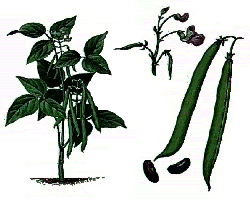 Bean is the common name for several leguminous plants, family Leguminosae, and their seeds and for several other unrelated species. Many beans are exceptionally good sources of vegetable protein and are important food staples. The name bean was originally applied to the broad bean, Vicia faba, also known as the Scotch, or Windsor, bean. This bean is still widely grown in Europe but is little known in the United States.
Bean is the common name for several leguminous plants, family Leguminosae, and their seeds and for several other unrelated species. Many beans are exceptionally good sources of vegetable protein and are important food staples. The name bean was originally applied to the broad bean, Vicia faba, also known as the Scotch, or Windsor, bean. This bean is still widely grown in Europe but is little known in the United States.
The best known bean plant of the New World is the common, snap, or kidney bean, Phaseolus vulgaris. Indigenous to Central America, it was widely disseminated in North and South America before European exploration, and distinct types had been developed. Forms include snap beans, which are consumed as the immature pods; green shell beans, which are eaten as full-size, immature beans removed from the pods; and dry shell, or kidney beans, which are used in the mature, dry form. String, stringless, and wax beans are varieties of the snap bean. Dry bean types include pinto, navy, Great Northern, red kidney, and pink beans.
The plants are annuals with a determinate (bush-type) or indeterminate (twining or pole-type) growth habit. The leaves have three leaflets; the flowers are of many colors; and the fruit is a legume, or pod, containing several white, red, or dark seeds. The pod may be round, oval, or flat in shape, and green, yellow, or red in color.
Snap beans are grown in every part of the United States, but commercial production for canning and freezing is highest in Wisconsin, Oregon, and New York, whereas production for fresh consumption is greatest in Florida, California, and New York. Dry-bean production is highest in Michigan, California, and Idaho.
The winged bean, Psophocarpus tetragonolobus, found in New Guinea and Southeast Asia, gained increased attention in the late 1970s and 1980s as a possible important food source for the future. Its cultivation is spreading. Almost all parts of the plant are highly nutritious, rich in protein and vitamins.
Other beans include the CAROB, CHICK-PEA, COWPEA, LIMA BEAN, and SOYBEAN (see also PULSE CROPS). Donald N. Maynard
Bibliography: Salunkhe, D. K., and Kadam, S. S., Handbook of World Food Legumes (1989).
The carob {kar'-uhb} is an eastern Mediterranean tree of the pea family, Fabaceae, and the source of carob or locust bean GUM, which is used as a stabilizer, thickener, and emulsifier in foods, cosmetics, pharmaceuticals, paints, and textile sizing and finishes. From 5 to 15 hard, brown seeds are produced in long, flat, leathery pods. The pods, containing a pulp consisting of about 50 percent sugar, are used mainly to feed livestock. The carob tree is sometimes known as locust or St. John's bread, from a theory that the "locusts" that John the Baptist ate in the wilderness were really carob pods.
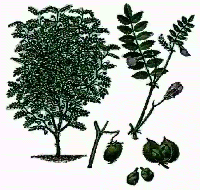 The chick-pea, also known as Egyptian pea, garbanzo, or gram, is cultivated for its edible nutritious seeds. It is, like beans and other peas, a member of the Leguminosae family. Indigenous to the Mediterranean area, it has been cultivated there since ancient times. The plant is a herbaceous, sprawling annual, 50 to 70 cm tall (20 to 28 in) at maturity. The leaves have 9 to 17 leaflets. The fruit is a legume, 2 to 3 cm long (0.8 to 1.2 in) and 1 cm wide (0.4 in) containing one or two rounded, light-colored seeds.
The chick-pea, also known as Egyptian pea, garbanzo, or gram, is cultivated for its edible nutritious seeds. It is, like beans and other peas, a member of the Leguminosae family. Indigenous to the Mediterranean area, it has been cultivated there since ancient times. The plant is a herbaceous, sprawling annual, 50 to 70 cm tall (20 to 28 in) at maturity. The leaves have 9 to 17 leaflets. The fruit is a legume, 2 to 3 cm long (0.8 to 1.2 in) and 1 cm wide (0.4 in) containing one or two rounded, light-colored seeds.
The chick-pea is propagated by seeds planted closely in rows 30 to 60 mm (1.2 to 2.4 in) apart. A minor crop in the United States, the chick-pea is an important food crop in India and the Middle East. It is also extensively grown in parts of Central and South America.
Chick-peas are eaten in soups, salads, and stews, and they may also be ground into a fine meal. Seeds may be roasted as a substitute for coffee, and the plant's acidic juice may also be used as a beverage. Donald N. Maynard
Clover, genus Trifolium, belongs to the pea family, Leguminosae. (The term clover also is applied to other plants with three-lobed foliage.) There are approximately 300 species of Trifolium, which are widespread in temperate and subtropical regions. Some species are valuable forage and cover crops; others are grown in lawns as ornamentals. As a LEGUME, clover is useful for building up nitrogen in the soil.
Clovers are annual, biennial, or perennial herbs. Some are low growing and trailing; others may grow up to 1 m (3 ft) tall. Leaves normally have three parts. The small white, pink, red, or yellow flowers are borne in dense, soft, rounded, or elongated heads. The most important forage clovers are red clover (T. pratense), crimson clover (T. incarnatum), and alsike clover (T. hybridum). White clover (T. repens), the original Irish SHAMROCK, is included in some lawn-seed mixtures. Other plants called clover are the leguminous Melilotus (sweet clover) and Lespedeae (bush or Japanese clover) and the nonleguminous Orthocarpus (owl's clover) and Richardia (Mexican clover).
 The cowpea, Vigna unguiculata, also known as the black-eyed pea, is a member of the legume family, Leguminosae. Native to Asia and Africa, it is grown for human food, for animal forage, and as a soil-improving crop. The cowpea thrives in hot climates and has drought tolerance, but it is quite susceptible to frost. It is grown commercially and in home gardens in the southern United States. Donald N. Maynard
The cowpea, Vigna unguiculata, also known as the black-eyed pea, is a member of the legume family, Leguminosae. Native to Asia and Africa, it is grown for human food, for animal forage, and as a soil-improving crop. The cowpea thrives in hot climates and has drought tolerance, but it is quite susceptible to frost. It is grown commercially and in home gardens in the southern United States. Donald N. Maynard
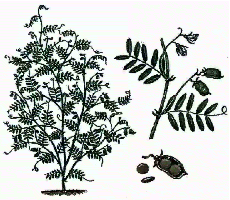 An annual plant, the lentil {len'-tul}, Lens culinaris, of the LEGUME family, Leguminosae, is among the most ancient of cultivated vegetables. It is believed to be indigenous to southwestern Asia and was cultivated in Egypt and Greece long before the biblical era. In the Bible it is probably the pottage vegetable that Esau traded for his inheritance. Today the vegetable is widely grown in temperate and subtropical climates. Over 3 million ha (7 million acres) of lentils are grown worldwide; India is by far the largest producer. In the United States lentils are raised mainly in Washington and Idaho.
An annual plant, the lentil {len'-tul}, Lens culinaris, of the LEGUME family, Leguminosae, is among the most ancient of cultivated vegetables. It is believed to be indigenous to southwestern Asia and was cultivated in Egypt and Greece long before the biblical era. In the Bible it is probably the pottage vegetable that Esau traded for his inheritance. Today the vegetable is widely grown in temperate and subtropical climates. Over 3 million ha (7 million acres) of lentils are grown worldwide; India is by far the largest producer. In the United States lentils are raised mainly in Washington and Idaho.
Lentils are grown for their seeds, which are rich in protein, and for animal forage (see PULSE CROP). The round, flattened seeds are contained in pods and must be threshed during harvesting. They range in size from 3 to 9 mm (0.118 to 0.354 in) and in color from white to green, brown, orange, and violet blue. Like beans, lentils can be dried and stored. They are eaten whole in soups and stews and are also ground into a flour. Yields in the United States are about 1,200 kg per ha (more than 1,000 lb per acre); in India, the yield is about 470 kg per ha (about 450 lb per acre).
O. A. Lorenz
Bibliography: Bajaj, Y. P., ed., Legumes and Oilseed Crops (1990); Duke, J. A., Handbook of Legumes of World Economic Importance (1981).
Lespedezas {les-puh-dee'-zuh} are several species of important crop plants, genus Lespedeza, widely grown for HAY and forage. Originally native to Asia, they are annual or perennial LEGUMES that generally stand about 30 cm (12 in) high, although some species are larger. The leaves consist of three leaflets marked by prominent veins or furrows. The inconspicuous flowers are usually bluish. Some species of lespedeza are also cultivated as ornamentals.
 The word licorice {lik'-uh-rish} refers both to the perennial herb Glycyrrhiza glabra of the legume family and to the flavoring produced from its roots. The plant grows to a height of about 1 m (3 ft) and has pealike blue flowers, flat pods, or legumes, and long, soft, flexible roots that are bright yellow inside. The roots are crushed, ground, and boiled to extract the juice, which is then thickened to produce hard black sticks of paste known as black sugar. The bittersweet flavoring is used in candy and tobacco, as a soothing ingredient in cough lozenges and syrups, as a laxative, and in the manufacture of shoe polish. Spain is the largest producer of licorice, but the plant is grown throughout the Mediterranean area, in parts of Asia, and in California and Louisiana. A wild species, G. lepidota, is native to North America.
The word licorice {lik'-uh-rish} refers both to the perennial herb Glycyrrhiza glabra of the legume family and to the flavoring produced from its roots. The plant grows to a height of about 1 m (3 ft) and has pealike blue flowers, flat pods, or legumes, and long, soft, flexible roots that are bright yellow inside. The roots are crushed, ground, and boiled to extract the juice, which is then thickened to produce hard black sticks of paste known as black sugar. The bittersweet flavoring is used in candy and tobacco, as a soothing ingredient in cough lozenges and syrups, as a laxative, and in the manufacture of shoe polish. Spain is the largest producer of licorice, but the plant is grown throughout the Mediterranean area, in parts of Asia, and in California and Louisiana. A wild species, G. lepidota, is native to North America.
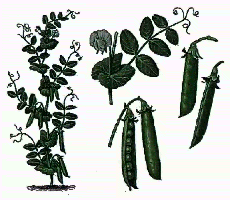 The garden pea, the vine Pisum sativum of the legume family, Leguminosae, is among the most widely grown vegetables, both for its high protein content and because it can easily be preserved by drying. Native to Eurasia, the pea was grown at least as long ago as the Bronze Age and, like certain other plants that have been cultivated for millennia, it can no longer be found growing in its original, wild form. Most peas are raised for their seeds, which are contained within pods and are harvested while they are young and tender. Snow, or sugar, peas have tender pods that can also be eaten. The field pea, variety arvense, is grown for drying and is also used as a green manure and a forage crop. Most commercial pea plantings are processed for canning or freezing.
The garden pea, the vine Pisum sativum of the legume family, Leguminosae, is among the most widely grown vegetables, both for its high protein content and because it can easily be preserved by drying. Native to Eurasia, the pea was grown at least as long ago as the Bronze Age and, like certain other plants that have been cultivated for millennia, it can no longer be found growing in its original, wild form. Most peas are raised for their seeds, which are contained within pods and are harvested while they are young and tender. Snow, or sugar, peas have tender pods that can also be eaten. The field pea, variety arvense, is grown for drying and is also used as a green manure and a forage crop. Most commercial pea plantings are processed for canning or freezing.
Cool temperatures are essential for good pea production. Seeds are usually planted very early in the spring, as they will germinate at temperatures even below 5 deg C (41 deg F). Frosts, however, will injure plants, blossoms, and pods. Temperatures above 25 deg C (77 deg F) can reduce the quality of taste and texture, as can a delayed harvesting, which produces peas that are tough and starchy.
The bulk of commercially produced peas come from Wisconsin, Washington, Minnesota, and Oregon, but home gardeners raise the vegetable in every state. The countless varieties available divide broadly into early types, which mature in less than 60 days, and late varieties that may require up to 75 days to mature. Leguminous relatives of the garden pea include the blackeyed pea, or COWPEA, the CHICK-PEA, and the LENTIL, all of which provide food and fodder; and the SWEET PEA, an ornamental plant grown only for its flowers. O. A. Lorenz
Bibliography: Crockett, J. U., Vegetables and Fruits (1986); Faust, J. L., The New York Times Book of Vegetable Gardening (1982); Splittstoessen, W. E., Vegetable Growing Handbook, 2d ed. (1984); Sutcliffe, J. F., and Pate, J. S., eds., The Physiology of the Garden Pea (1977); Wyman, D. J., The Gardening Encyclopedia (1987).
 The peanut, Arachis hypogaea, of the legume family, is a tender, herbaceous viny plant that produces edible seeds, also called peanuts (or goobers, pindars, ground nuts, or grass nuts). Native to South America, the plant was introduced to Africa by European explorers and reached North America with the slave trade. Its value as a food crop was recognized only in the late 19th century, and it is now cultivated in more than 40 countries on 6 continents. In order of production, India, China, Nigeria, Senegal, the United States, Indonesia, Sudan, and Burma (Myanmar) are the major producers.
The peanut, Arachis hypogaea, of the legume family, is a tender, herbaceous viny plant that produces edible seeds, also called peanuts (or goobers, pindars, ground nuts, or grass nuts). Native to South America, the plant was introduced to Africa by European explorers and reached North America with the slave trade. Its value as a food crop was recognized only in the late 19th century, and it is now cultivated in more than 40 countries on 6 continents. In order of production, India, China, Nigeria, Senegal, the United States, Indonesia, Sudan, and Burma (Myanmar) are the major producers.
Cultivation
Peanuts grow best in slightly acid, sandy soil. Soil calcium is essential; its lack impairs plant development or aborts seed. Plants require a long growing season to mature seeds and will not tolerate frost. Although they form underground, the edible portions of the plant are not tubers but seeds housed in a capsule--a nutlike shell. The plant bears yellow male flowers and inconspicuous female flowers. After fertilization, the peduncle, or flower stalk, elongates, forcing the growing seed pod underground, where it reaches maturity. Peanuts are broadly classified into two major types: runner varieties grow small, round, pink-skinned seeds in two-seeded pods; bunch types produce larger, deep-red seeds that grow three to a pod.
Most commercially grown peanuts are mechanically harvested, artificially cured, and automatically handled and shelled.
Although peanuts may be held for up to five years under optimum conditions, poor storage practices can produce inedible nuts within a month. Mold, insect infestation, discoloration, absorption of foreign flavors, and staleness or rancidity are major causes of stored-peanut loss. Peanuts and peanut meal are particularly susceptible to infestation by the molds that produce the poisonous substance aflatoxin.
The Peanut Industry
Peanut growing in the United States began in the post-Civil War era, when Southern farmers, beset by the ravages of the boll weevil, sought a substitute crop for cotton. As peanut acreage grew, numerous uses for the plant and its seed were gradually found. The most famous researcher into the potential for the peanut crop was George Washington CARVER, whose discoveries helped establish the industry. Major peanut-growing states are Georgia, Alabama, North Carolina, and Texas. The United States produces about 3.5% of the total world crop.
The peanut contains about 28% protein, 50% oil, 18% carbohydrates, and 4% ash. Few agricultural plants have as many potential uses. In the United States, peanut butter is the most important peanut product; very little peanut butter is consumed in other countries. Worldwide, about two-thirds of the peanut crop is crushed for oil, and peanut oil supplies about 8% of the world's edible oil production. Peanut products are used in food processing; animal feed products include feed made from the shell and from the residues left after oil pressing. Plants left in the ground provide excellent forage for cattle and swine and are also valuable as a green manure.
Donald K. Ourecky
Bibliography: Johnson, F. Roy, The Peanut Story, rev. ed. (1964; repr. 1977); Woodruff, J. G., Peanuts: Production, Processing and Products, 3d ed. (1983); Zisman, H. and L., The Great American Peanut Butter Book (1985).
Pulse crops, or grain LEGUMES, are various leguminous plants in use around the world as human foods and as forage plants and fodders for domesticated animals. The term pulse refers specifically to the seeds of these plants, but other plant parts are also often eaten. Pulse crops are a major source of protein in the diet, and many legumes also supply various fats and oils. Because most legumes can enrich soils through the action of nitrogen-fixing bacteria on their roots, a number of pulse crops are used agriculturally for this purpose as well (see NITROGEN CYCLE).
Among the most commonly used grain legumes are the SOYBEAN, the PEANUT, and the many species of PEAS and BEANS (see also LIMA BEAN). Other pulse crops of more limited or geographically restricted use include the CAROB, CHICK-PEA, COWPEA, FENUGREEK, LENTIL, LUPINE, MESQUITE, and VETCH. Several further legumes may also be grouped with the pulse crops, although some are cultivated only locally. These include the catjang or pigeon pea (Cajanus), jack bean (Canavalia), guar (Cyamopsis), lablab (Dolichos), wild pea (Lathyrus), white popinac (Leucaena), velvet bean (Mucana), and Bambara groundnut (Voandzeia).
In many tropical and subtropical regions of the world, food sources among the poor tend to be low in protein. For this reason, the Food and Agricultural Organization of the United Nations, along with other groups, is supporting research into wider development of local pulse crops such as guar and the winged bean (Psophocarpus; see BEAN).
Bibliography: Aykroyd, W. R., and Doughty, Joyce, Legumes in Human Nutrition, 2d ed. (1982); Duke, J. A., A Handbook of Legumes of World Economic Importance (1981); Smartt, J., Tropical Pulses (1976); Summerfield, R. J., and Roberts, E. H., eds., Grain Legume Crops (1985).
See also: AGRICULTURE AND THE FOOD SUPPLY; DIET, HUMAN .
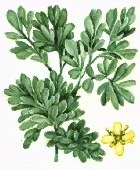 Rue, the common name of the genus Ruta of perennial herbs, comprises 40 species of plants that originate in southern Europe. The rue family, Rutaceae, also includes such citruses as orange and lemon trees and such trees as satinwood, which yields timber used in cabinetry.
Rue, the common name of the genus Ruta of perennial herbs, comprises 40 species of plants that originate in southern Europe. The rue family, Rutaceae, also includes such citruses as orange and lemon trees and such trees as satinwood, which yields timber used in cabinetry.
Common rue, or herb of grace, R. graveolens, a shrublike herb, has a woody base and aromatic blue green leaves that are evergreen in warmer climates. It bears yellow flowers and fruit consisting of capsules divided into four or five lobes. During earlier centuries, it was believed to cure such maladies as poisoning and gout; today it is used to flavor an alcoholic beverage of northern Italy known as grappa.
Goat's rue, Galega officinales, a perennial herb of the legume family, Leguminosae, is grown as an ornamental shrub and is also cultivated for animal feed. Meadow rue is the common name for the genus Thalictrum, also perennial herbs.
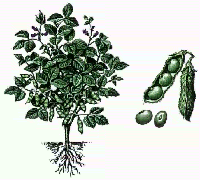 The soybean, Glycine max, is a leguminous crop grown in many parts of the world and is of great economic significance as a source of edible oil and of high-protein foods and stockfeed. It is a cultigen (a species created through cultivation) and is not known in the wild. Its wild ancestor is believed to be Glycine ussuriensis, a rambling vine native to northeastern Asia. Other relatives are found in parts of Asia and in Australia and Africa. Like many leguminous crops, the soybean has lost the winding and climbing growth pattern of its wild relatives. It is an erect, bushy herb growing to a height of 30-90 cm (1-3 ft) and developing a profusion of roots that may reach up to a meter or more (3-4 ft) in loose soils.
The soybean, Glycine max, is a leguminous crop grown in many parts of the world and is of great economic significance as a source of edible oil and of high-protein foods and stockfeed. It is a cultigen (a species created through cultivation) and is not known in the wild. Its wild ancestor is believed to be Glycine ussuriensis, a rambling vine native to northeastern Asia. Other relatives are found in parts of Asia and in Australia and Africa. Like many leguminous crops, the soybean has lost the winding and climbing growth pattern of its wild relatives. It is an erect, bushy herb growing to a height of 30-90 cm (1-3 ft) and developing a profusion of roots that may reach up to a meter or more (3-4 ft) in loose soils.
History
The cultivation of soybeans in China predates recorded history and spread from there to other countries in eastern Asia before the modern period. So essential was the soybean to Chinese civilization that it was considered one of the five sacred grains (the others being rice, barley, wheat, and millet). The popularity of soybeans in the Orient was due to their wide use as a food. Tofu, a curd made from coagulated soybean milk, has become well known to Western eaters of East Asian cuisines.
In the late 19th century the soybean plant attracted the attention of the U.S. Department of Agriculture (USDA), which began introducing a number of varieties into the United States. The vegetable oil industry became interested in the plant's potential. Starting in the 1930s, a large cooperative program involving both U.S. and Canadian researchers began to develop improved soybean varieties through selective breeding. This program led to the introduction of varieties that differed markedly from the original Asian plants. The new varieties had higher yields and oil content. With these new varieties, the United States became the world's leading producer of soybeans. The rapid increase in production in a few decades is one of the most striking developments in U.S. agricultural history.
From American strains, soybean cultivation has recently spread to numerous countries in Asia, Africa, and Latin America. Genetic improvement, which aims at higher yields as well as improved protein composition, began late in the United States. As a result, American soybeans represent a narrow range of genetic variation.
Cultivation and Characteristics
Soybeans do not tolerate frost and are photoperiod-sensitive, which means that flowering cannot begin until summer nights grow longer. Plants require abundant moisture and, in the absence of irrigation, do not do well in areas of winter precipitation such as Europe and Pacific America. Soybeans do best in fertile loams but can be grown in most soils. Depending on the variety, soybean plants mature in 75 to 200 days. When used as a green manure, the plants are plowed under while still green. After the leaves fall and the pods and stems dry naturally, the seeds are harvested with combines. Soybean seeds are hard, generally yellow, and pea-shaped. Like other leguminous plants, the soybean can associate with nitrogen-fixing bacteria found in the soil.
Uses
Soybeans are an important human food because they are unusually complete in proteins: of the eight essential amino acids, soybeans contain seven in sufficient quantity and are deficient only in methionine, which can be supplied from wheat or corn. Soybeans are eaten in numerous ways--as a green or dried bean and as the constituent of soy milk, curds, cheese, and various sauces--and are a major source of vegetable oil. Soybean protein is increasingly used as a meat imitation, or meat substitute. Soybean products are also important in animal feeds, and the green crop is used for hay, forage, and as a fertilizer. In addition, a number of industrial uses have been developed: the manufacture of glycerin, paints, soaps, linoleum, rubber substitutes, plastics, and printing ink.
In the United States, almost half of the soybean oil produced is used in margarine and shortening, and another 20 percent is used to make other food products. Almost all of the soybean meal, the high-protein residue from the processing of soybean oil, is used to feed poultry and livestock.
Principal Areas of Cultivation
The world's four major national producers of soybeans are the United States, which produces almost 50 percent of the world crop (mainly in the Corn Belt and the South), and Brazil, China, and Argentina, which together account for more than one-third of the world's production. Minor producing countries, where soybeans are of some consequence, include Canada, Indonesia, Mexico, India, Paraguay, and the far east regions of Russia.
Drought can depress soybean-production totals significantly. In 1980, for example, the worldwide soybean harvest fell--from the previous year's 90 million metric tons--to 80 million metric tons because of drought. World production figures reached their highest level in the early 1990s, well over 100 million metric tons annually.
Bibliography: Houck, James P., et al., Soybeans and Their Products (1972); Levitan, R., Tofu, Tempeh, Miso, and Other Soy Foods (1982); Norman, G. A., Soybean Physiology, Agronomy, and Utilization (1978); Scott, W. O., and Aldrich, W. J., Modern Soybean Production, 2d ed. (1983); Watanade, Tokuji, and Kishi, Asako, The Book of Soybeans: Nature's Miracle Protein (1982); Wilcke, Harold L., et al., eds., Soy Protein and Human Nutrition (1979); Wilcox, J. R., ed., Soybeans: Improvement, Production, and Uses, 2d ed. (1987).
Vetch (or tare) is the common name for about 150 mostly north temperate and South American species of climbing or straggling, weak-stemmed, viny herbs in the genus Vicia of the pea family, Leguminosae. They have compound leaves and the terminal leaflets are transformed into tendrils. Some are cultivated as forage crops (hay, pasture, and silage); others are used as cover crops and as green manure, because they are legumes. Oswald Tippo
_Copyright (c) Grolier Electronic Publishing, Inc._
THANKS FOR VISITING! GOD BLESS YOU!